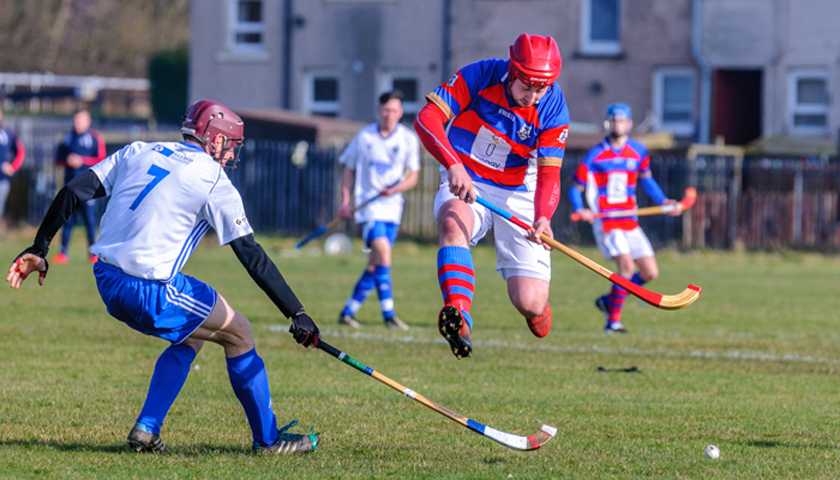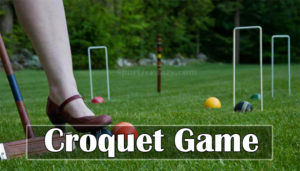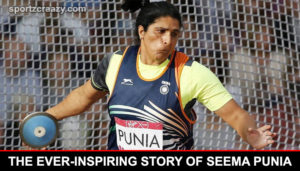Historically, a singular point of origin for shinty cannot be stated, because it developed from the rough sketch of the primitive stick-and-ball games which predate written historiography (or oral thereof). One thing that can be attested, instead, is that it shared its roots with two more similar games played in other corners of the British isles: the Irish game of Hurling, which predates the known history of Ireland itself, and the less widely known game of cammag on the Isle of Man.
The earlier prototype of Hurling engaged in the northern, frigid regions of Ireland had the closest structural similarity to the Scottish game of shinty – so much so that they were nearly identical, even called with the same name ‘camanacht’. To celebrate this common root in the earliest point of their evolution, Ireland and Scotland annual participate in a matchup of a composite product of Hurling and Shinty, with merged rules.
Earlier called ‘ioman’, speculations attribute the coinage of ‘shinty’ (shinnack and shinnins in alternate dialects; etymological predecessor ‘shintie’) to the traditional Gaelic cries used in the game, such as shin ye, shin’t ye, and shin you, or perhaps from the Scottish Gaelic word sinetag (a leap), as broadcaster and sports academic Hugh Dan McLennan stipulates, or even the English ‘shin’. Although all such perorations simply its origins and do not account for the many locale-specific variations of the term, e.g. knotty, cammock, and Hailes in the Scottish Lowlands.
Because of their tangled historical roots, shinty, its Irish counterpart Hurling, and the early forms of the more popular hockey has visually and functionally similar components – the positions, field proportions, objectives, and some contact rules to name a few.
Shinty Game – How to Play
The objective is straightforward, to outscore the opponent team with goals. The two teams facing off consist of 12 players each (or 10 players in women’s shinty). The primary equipment is the caman – a bat closely resembling its Irish counterpart, the hurley. As the ball, a cork core wrapped in leather is chiefly used, just like the sliotar in Hurling.
A goal is scored by swinging the caman bat, and hitting the ball into the goal. For the goal to count, the ball only has to be inside the post, referred to colloquially as ‘hail’, and cross the goal line. Contrary to some offshoots of shinty, the ball must be set in motion from a caman strike for it to count – balls hit by hands, feet or any other means are discounted.
A standard playing field for shinty is much larger than a hockey pitch, usually measured at 140-170 yards at length and 70-80 yard at width (as opposed to modern hockey’s usual 100-yard x 60 yards court). At each end of the length are the hails i.e. goalposts, 12 ft wide and 10 ft high. Like football and hockey, the central line and penalty area are clearly demarcated. The penalty area in shinty is generally a 10-yard radius along with the hail.
Like football, Shinty did not have any player substitution system, until it was implemented in the 1960s. As per current rules, a Shinty team is permitted to have a maximum of five substitutes on the bench, ready to be swapped at any time with an active player – so long as the latter comes off the pitch first.
Like the football kick-off, the players are lined up mostly in accordance with their formations at the start of the match, except it is a ‘throw up’. The ball is thrown into the air vertically, and the throw-up player for both teams try to swing their bat and catch it to gain possession.
Once a team has possession, the aim is, naturally, to set up the deck for a goal opportunity. The rules that permit the players to advance the ball up the pitch in such-and-such ways are similar to Hurling for the most part.
A player can pass the ball to a teammate in any direction. This can either be a ground pass, or the player can play the ball in the air as well if it is with his bat.
Other than passing, a player can singularly move with the ball up the court dribbling the ball. They can use both sides of the stick to dribble it and defend it from tackles. A rare albeit still useful situational tool of carrying the ball forward is the keepy-uppy. Just the same as in Hurling, the attacking player can choose to balance the ball on his stick while making a run, or bouncing it in poise.
The two things particularly unique to shinty are: firstly, you can stop or receive the ball with your chest, and secondly, you can play the ball in the air using both feet together.
Alternately, the player can intercept the ball with his foot, but only if it is moving along the ground.
The defending team will attempt to tackle and dispossess the player. The two common ways are textbook dispossession tactics – impeding the movement of the ball with their stick, or snatching the ball away before the opponent can react and swing. Hacking, chopping, or blocking the opponent’s bat, is an illegal move in Shinty and earns the opponent a free-hit, where the opposing team gets to take a static shot, and all other players must retreat a distance of at least 5 yards from the striker. Reckless fouls are also punished by a cautionary yellow card, or the red card, which removes the player from play. Similar to football, hit-offs and corners are arranged when the ball moves outside the boundary.
The games are played in two 45 minute halves, plus stoppage time and injury time as decided by the referee. If it ends in a tie, penalty playoffs are arranged till a victor is determined.
Like many other sports that originated in the British isles, shinty was formalized in the late Victorian era. Other than the shinty and hurling composite international, most shinty action today is found in Scotlands, where it has a stable foothold with various cups (e.g. Camachand Cup and Glasgow Celtic Society Cup) and a hierarchical shinty league system with a premier division and three other divisions under it.
Shinty Game – Rules
Teams consist of 12 players (10 in the women’s game), including a goalkeeper and matches are played over two 45-minute halves. The main objective is to score more goals than the other team by hitting the ball through the goalposts with the caman. A goal doesn’t count if the ball “has been kicked, carried or propelled by hand or arm by a player of the attacking side”. A player can tackle an opponent with their stick and their body as long as it is shoulder-to-shoulder. A player can stop the ball using their stick, chest or foot and only the goalkeeper can use their hands, even though they can’t catch it.
The field play is usually 140-170 (128-155m) yards long and 70-80 yards (64-73m) wide. The “D” in front of each goalpost is 10 (9.1m) yards in radius and the penalty spot is 20 yards (18.3m) from the goalpost. The goalposts themselves are 12ft (3.6m) wide and 10ft (3.0m) high while the centre has a 5-yard (4.5m) radius.
Also Check:










